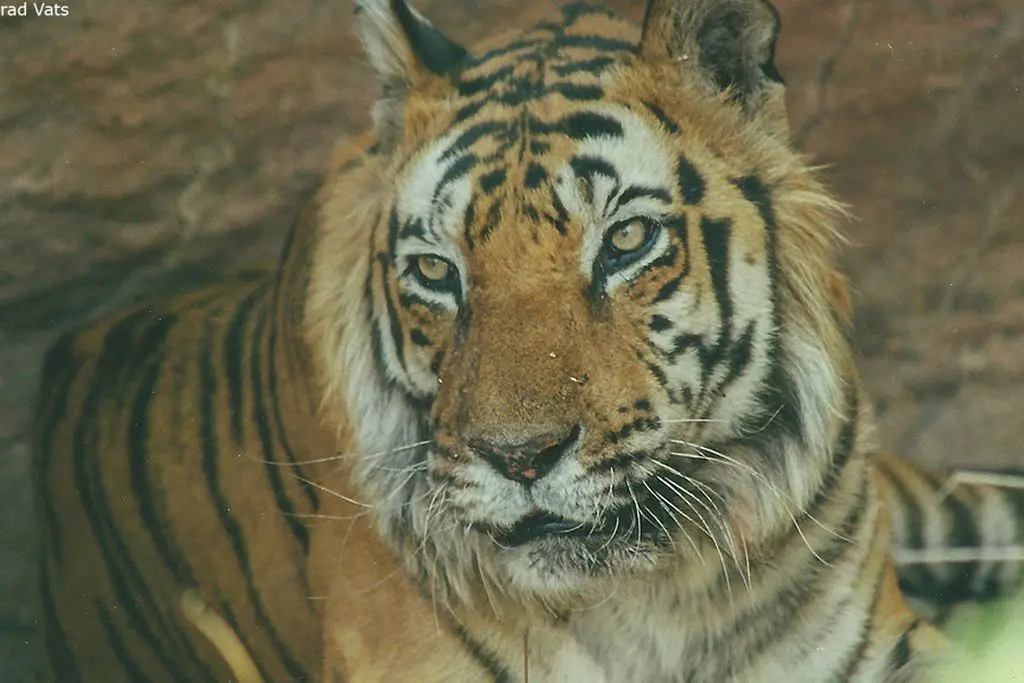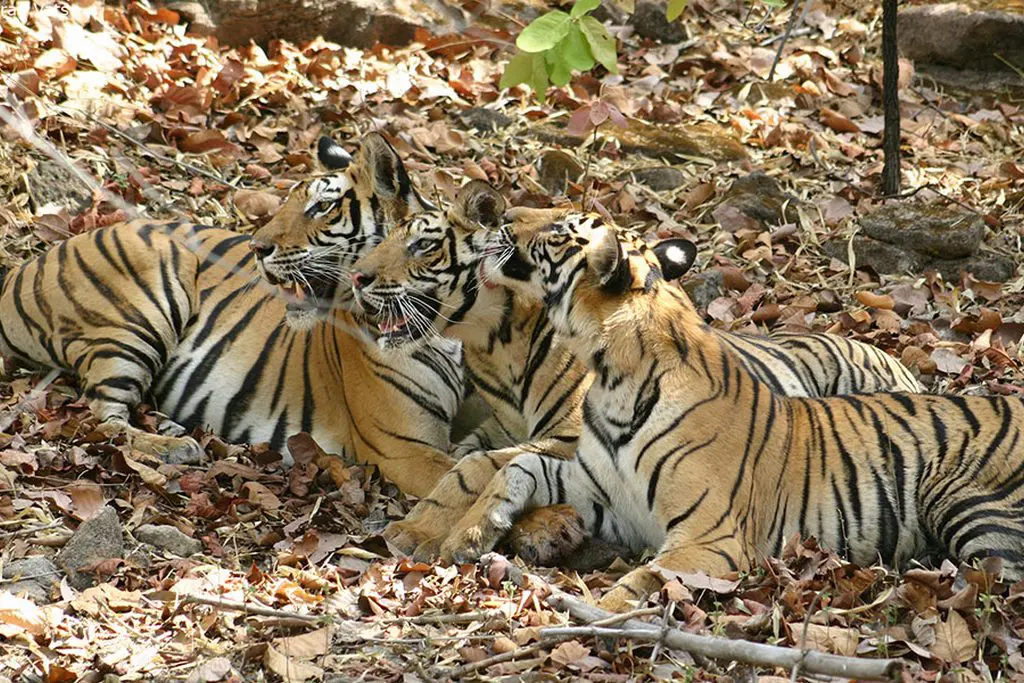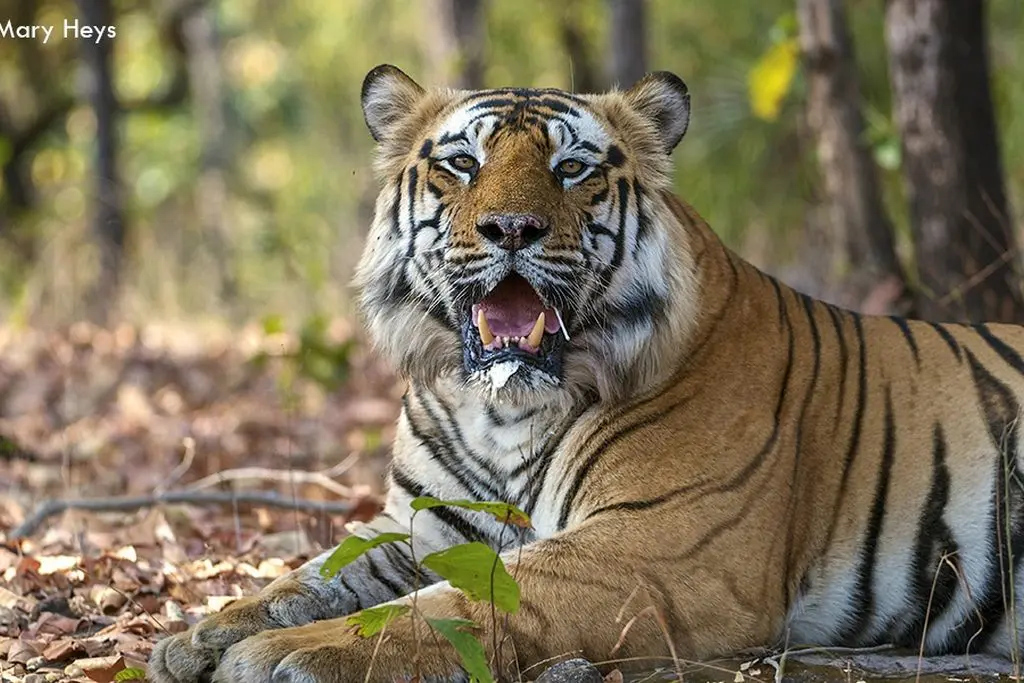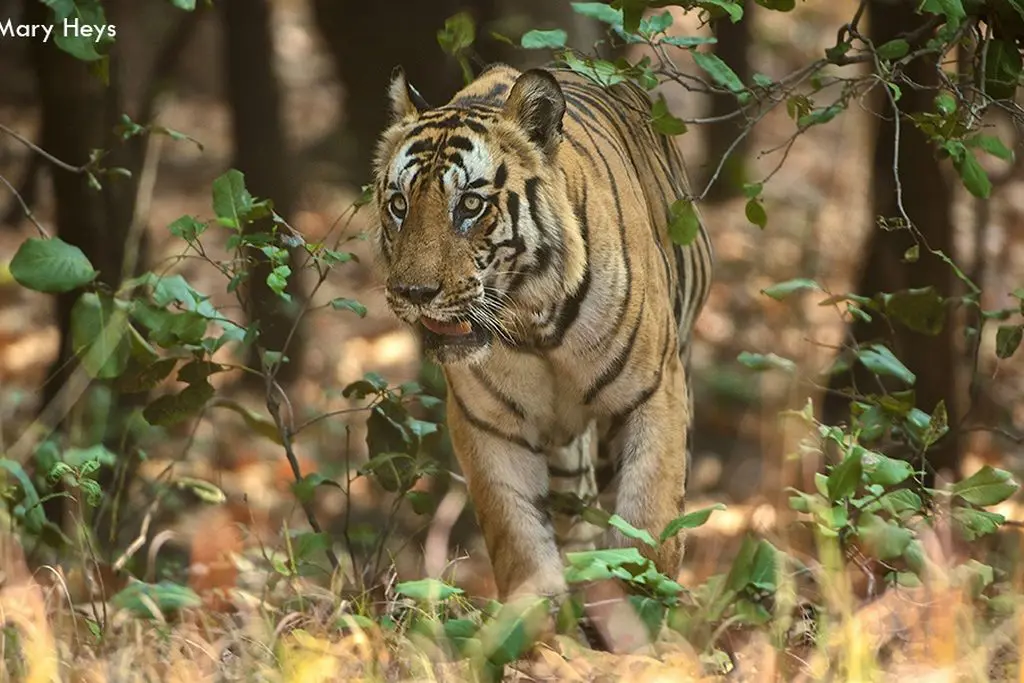India’s landscapes are home to the legendary tigers of India, symbols of both natural power and ecological importance. From Ranthambore’s Machali to Pench’s Collarwali, these apex predators have shaped wildlife narratives. The stories of T24 (Ustad) and Munna highlight the complexities of human-wildlife conflict. These legendary tigers of India are vital to their ecosystems, demanding robust conservation to combat habitat loss and poaching. Their continued existence underscores the need to protect India’s rich biodiversity. By focusing on these iconic individuals, we emphasize the urgent need to preserve India’s wildlife heritage. The presence of the legendary tigers of India serves as a stark reminder of our responsibility to protect these majestic creatures.
Machali (The Queen of Ranthambore)
Machali, affectionately dubbed the “Queen of Ranthambore,” wasn’t just another tiger; she was a bona fide celebrity in the wildlife world. Born in ’97, she quickly became a symbol of tiger royalty, strutting her stuff with unparalleled grace and a fearless attitude that made her the most photographed tigress on the planet. For over a decade, she ruled Ranthambore National Park with an iron paw, successfully raising multiple litters and defending her territory like a boss. Seriously, she once took on a 14-foot crocodile, proving she was no ordinary feline.
Living to an impressive 19 years, she became a tourism goldmine, boosting conservation efforts and captivating hearts worldwide. Even now, long after her 2016 departure, Machali remains a legend, starring in documentaries and living on in the memories of wildlife aficionados everywhere by making her name in legendary tigers of India.
Collarwali (Queen of Pench)
Collarwali, a name synonymous with resilience and maternal prowess, rightfully earns her place among the legendary tigers of India. Known affectionately as the “Supermom of Pench,” this extraordinary tigress of Pench Tiger Reserve made an indelible mark on tiger conservation. Born in 2005, she inherited a lineage of strength from her parents, T-15 and T-1, but carved her own unique identity. The radio collar, initially a tracking device, became her iconic identifier, a rare distinction among her wild counterparts, and cemented her place in the annals of wildlife history.
Collarwali’s fame stemmed from her unparalleled ability to raise an astonishing 29 cubs across eight litters, a feat unmatched in the wild. This remarkable record underscored her exceptional mothering skills, her adaptability to the forest’s challenges, and her unwavering dedication to ensuring the survival of her offspring. Her ability to navigate the complexities of her territory, provide sustenance for her cubs, and maintain her dominance cemented her legendary status.
Beyond her reproductive success, Collarwali became a symbol of Pench’s thriving tiger population, attracting wildlife enthusiasts and photographers from around the globe. Her captivating story was immortalized in the BBC’s “Spy in the Jungle” documentary, which offered a glimpse into her remarkable life as a mother and her profound influence on the ecosystem. Her majestic presence and contributions to the region made her an ambassador for tiger conservation, highlighting the importance of protecting these magnificent creatures. At the age of 16, Collarwali passed away, leaving behind an unparalleled legacy and a thriving lineage that continues to roam the forests of Pench, ensuring her impact endures as a testament to the legendary tigers of India.
Charger (The Dominant Male of Bandhavgarh)
Charger, a name that resonates with raw power and territorial assertiveness, stands as a titan among the legendary tigers of India, particularly within the storied Bandhavgarh Tiger Reserve. He wasn’t just another male tiger; he was a force of nature, earning the moniker “Charger” for his decidedly direct approach to territorial defense, a habit of charging safari vehicles and any perceived intruder with a level of boldness that bordered on legendary.
Emerging onto the Bandhavgarh stage in the early 1990s, Charger formed a formidable alliance with Sita, a tigress whose own fame was equally well-deserved. Together, they reigned supreme over the Tala Zone, establishing a dynasty marked by numerous offspring and a thriving tiger population that became the pride of the reserve. His physique, distinguished by striking markings and a commanding presence, made him an irresistible subject for wildlife enthusiasts and photographers alike, solidifying his iconic status.
Charger’s relentless defense of his territory against rival males ensured the continuation of his lineage and maintained the delicate balance of the ecosystem, a testament to his pivotal role in Bandhavgarh’s natural history. After a life that was nothing short of eventful, Charger’s reign ended in 2000, leaving behind a legacy of dominance and resilience that continues to fuel conservation efforts and inspire tales of the majestic tigers that roam Bandhavgarh.
Sita (The Photogenic Tigress of Bandhavgarh)
Sita, a tigress whose image graced the covers of renowned publications, earned her title as the “Photogenic Tigress of Bandhavgarh” through her captivating beauty and tranquil nature. She wasn’t just a pretty face, though; Sita played a vital role in Bandhavgarh’s tiger population growth, successfully raising numerous cubs who themselves became territorial residents. Her legendary partnership with Charger, the reserve’s dominant male, contributed significantly to the ecological stability of the region. Her life, showcasing her elegance, hunting skills, and maternal dedication, was famously documented in “Land of the Tiger,” solidifying her iconic status. While her life was tragically cut short by poaching in 2000, Sita’s memory continues to inspire, symbolizing the enduring spirit of Bandhavgarh’s tigers.
Mohan (The First Captured White Tiger)
Mohan, the first captured white tiger, holds a singularly significant position among the legendary tigers in India, marking a pivotal moment in wildlife history. In 1951, within the forests of Rewa, Madhya Pradesh, Maharaja Martand Singh’s capture of Mohan initiated a lineage that would populate zoos and wildlife parks globally. This extraordinary event began with local villagers’ reports of an unusual white tiger cub among its conventionally colored siblings. Following a determined search, Mohan was brought to the Maharaja’s palace, where breeding efforts successfully propagated the rare white tiger gene, ensuring its survival in captivity.
Mohan’s striking appearance, a manifestation of leucism, a genetic mutation, ignited a global fascination with white tigers. His legacy extends far beyond his initial capture, as his descendants serve as ambassadors for tiger conservation in various institutions worldwide. While ethical considerations surrounding captive breeding continue to be debated, Mohan remains an enduring symbol of India’s rich biodiversity and stands as a testament to the awe-inspiring genetic variations found within the animal kingdom, securing his place amongst the most legendary tigers in India.
T24 (Ustad of Ranthambore)
T24, or Ustad, stands as one of the most debated and intriguing figures among the tigers of Ranthambore Tiger Reserve. His powerful presence and distinctive appearance were overshadowed by allegations implicating him in the deaths of four individuals, including a forest guard, between 2010 and 2015. His perceived comfort around humans generated a mix of fascination and fear, elevating his status among wildlife observers.
The pivotal moment arrived in May 2015, following the forest guard’s death, when Ustad was relocated to Sajjangarh Biological Park in Udaipur, triggering a nationwide discussion about human-wildlife conflict. This relocation ignited a complex debate, with conservationists questioning the true nature of his actions and whether they were rooted in instinct or misinterpretation. Ustad’s narrative brought global attention to the delicate equilibrium required for human and wildlife coexistence, emphasizing the challenges tigers encounter in shared habitats.
Regardless of the controversies, Ustad’s story remains a poignant reminder of the majestic yet intricate nature of India’s wild tiger populations.
Munna (The Legendary Tiger of India & King of Kanha)
Munna, affectionately dubbed “The King of Kanha,” holds a legendary status among the legendary tigers of India, particularly within Kanha Tiger Reserve. His striking “CAT” marking on his forehead, a unique identifier, and commanding presence made him a favorite among wildlife photographers and enthusiasts. Born around 2004, Munna dominated a large territory, demonstrating his strength and territorial control, solidifying his place amongst the legendary tigers of India.
His bold nature and frequent appearances made him a star attraction for visitors from around the world. Munna’s longevity, a rarity for wild tigers, further contributed to his fame. In 2019, due to his advanced age and territorial conflicts, he was relocated to Van Vihar National Park in Bhopal. Munna’s passing in 2021 left a lasting impact, solidifying his position as one of Kanha’s most iconic tigers and inspiring ongoing admiration for India’s magnificent wildlife and the legendary tigers of India that roam its diverse landscapes.
Bamera (The Enigmatic Male of Bandhavgarh)
Bamera, frequently referred to as “The Enigmatic Male of Bandhavgarh,” stands among the legendary tigers of India, recognized for his immense stature, dignified presence, and aura of mystery. Born in 2008, he carried forward a lineage of strength and dominance. Initially reserved, he evolved into a formidable tiger, ultimately presiding over the Tala Zone of Bandhavgarh Tiger Reserve. His unique, solitary, and non-confrontational disposition distinguished him from other dominant males, as he patrolled his extensive territory with a serene confidence, a hallmark of the legendary tigers of India.
Despite his power, Bamera was known for his avoidance of unnecessary conflicts, demonstrating a rare combination of might and composure. His striking physical attributes made him a favored subject for wildlife photographers, and his progeny significantly contributed to Bandhavgarh’s robust tiger population. Though his reign eventually succumbed to age and rival challenges, Bamera’s legacy as a majestic and enigmatic ruler of Bandhavgarh remains deeply etched in the memories of wildlife aficionados, cementing his place among the legendary tigers of India.
B2 (The Mighty Tiger of Bandhavgarh)
B2, a prominent figure among the legendary tigers of India, commanded attention within Bandhavgarh Tiger Reserve through his striking physical presence and unwavering territorial control. Inheriting a lineage of power, he swiftly asserted his dominance over the park’s Tala Zone. His easily identifiable features, characterized by a robust, muscular build and distinctive facial markings, made him a favorite subject for both wildlife enthusiasts and photographers.
B2’s territorial reign was defined by his fearless encounters with rival tigers, demonstrating a blend of aggression and calculated strategy to maintain his supremacy, a trait often seen amongst the legendary tigers of India. He also contributed significantly to Bandhavgarh’s tiger population by fathering numerous litters. Though his life ended prematurely in 2011, when he was fatally challenged by his own son, B2’s legacy as one of Bandhavgarh’s most iconic and powerful tigers remains, symbolizing the park’s vibrant tiger population and its essential role in conservation efforts, ensuring his place amongst the legendary tigers of India.
Matkasur (Tadoba’s King)
Matkasur, popularly known as “Tadoba’s King,” stands among the legendary tigers of India, holding a position of dominance and photographic appeal within the Tadoba Andhari Tiger Reserve. His striking physical form and captivating presence allowed him to rule the forests with undisputed authority, making him a favored subject for both wildlife enthusiasts and photographers. Named after the Matka region, where he was often spotted, Matkasur displayed a compelling blend of aggression and territorial mastery, frequently observed patrolling his extensive territory with unwavering confidence, a trait common among the legendary tigers of India.
His encounters with rivals and interactions with tigresses like Maya have become celebrated stories within the park. Matkasur’s contribution to Tadoba’s thriving tiger population is substantial, as he fathered numerous cubs, ensuring the continuation of his genetic lineage, a key characteristic of the legendary tigers of India. His regal presence and ability to dominate his domain solidified his title as “Tadoba’s King,” securing his place as one of the park’s most iconic and celebrated tigers.
Baavan (The tigress who contributed for the research in Panna)
Baavan, also known as F-123, was the second tiger to be radio-collared during the 10-year-long tiger ecology project in Panna. She was named Baavan because of the distinct ‘5’ and ‘2’ markings on her forehead — in Hindi, 52 is pronounced “Baavan.” This long-term research project was led by renowned conservation biologist Dr. Raghu Chundawat and sanctioned by the Smithsonian Institution.
It was the longest-running tiger study project in India. During that project Baavan was observed by the team for nine years; although other tigers were also radio-collared, she remained the most closely monitored. Much of the knowledge and data about tiger ecology during that period came from studying Baavan and her family. She and her lineage became an integral part of the project team’s life and research.
If you wish to find the amazing wonders of wild, then book your wildlife safari tour with us today. At Nature Safari India, we provide the best experience for your wildlife safari with a luxurious touch. We take care of all your needs by creating a tailor made itinerary which will suits your wildlife vacation.







